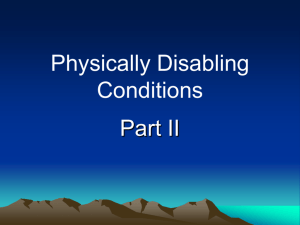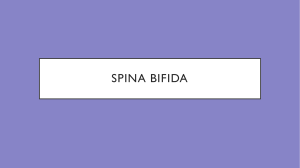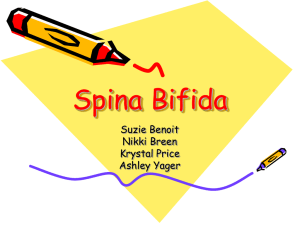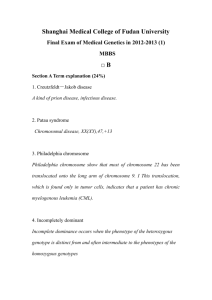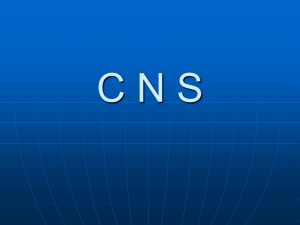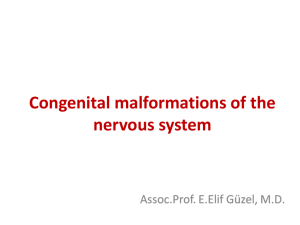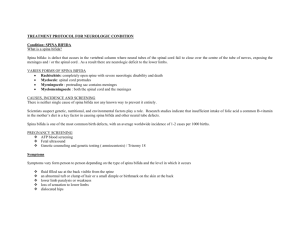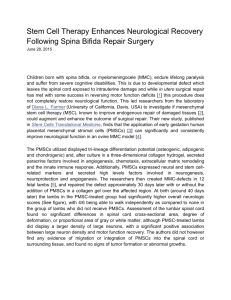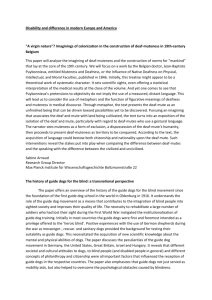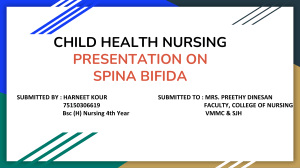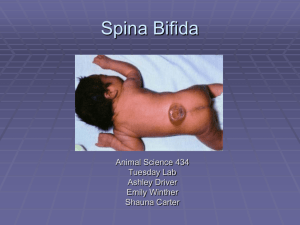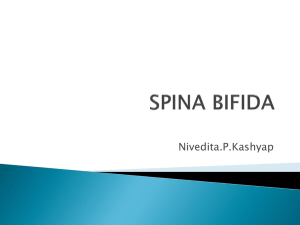SPINA BIFIDA
advertisement
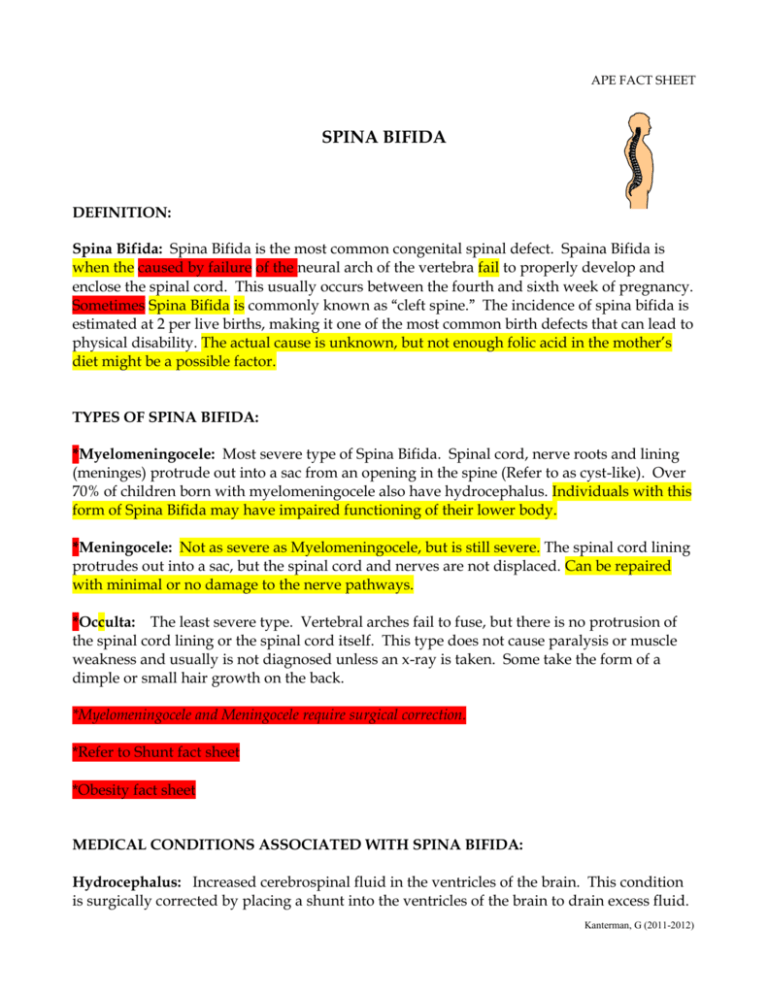
APE FACT SHEET SPINA BIFIDA DEFINITION: Spina Bifida: Spina Bifida is the most common congenital spinal defect. Spaina Bifida is when the caused by failure of the neural arch of the vertebra fail to properly develop and enclose the spinal cord. This usually occurs between the fourth and sixth week of pregnancy. Sometimes Spina Bifida is commonly known as “cleft spine.” The incidence of spina bifida is estimated at 2 per live births, making it one of the most common birth defects that can lead to physical disability. The actual cause is unknown, but not enough folic acid in the mother’s diet might be a possible factor. TYPES OF SPINA BIFIDA: *Myelomeningocele: Most severe type of Spina Bifida. Spinal cord, nerve roots and lining (meninges) protrude out into a sac from an opening in the spine (Refer to as cyst-like). Over 70% of children born with myelomeningocele also have hydrocephalus. Individuals with this form of Spina Bifida may have impaired functioning of their lower body. *Meningocele: Not as severe as Myelomeningocele, but is still severe. The spinal cord lining protrudes out into a sac, but the spinal cord and nerves are not displaced. Can be repaired with minimal or no damage to the nerve pathways. *Occulta: The least severe type. Vertebral arches fail to fuse, but there is no protrusion of the spinal cord lining or the spinal cord itself. This type does not cause paralysis or muscle weakness and usually is not diagnosed unless an x-ray is taken. Some take the form of a dimple or small hair growth on the back. *Myelomeningocele and Meningocele require surgical correction. *Refer to Shunt fact sheet *Obesity fact sheet MEDICAL CONDITIONS ASSOCIATED WITH SPINA BIFIDA: Hydrocephalus: Increased cerebrospinal fluid in the ventricles of the brain. This condition is surgically corrected by placing a shunt into the ventricles of the brain to drain excess fluid. Kanterman, G (2011-2012) Removing the excess cerebrospinal fluid protects the child against brain damage resulting from pressure on the brain. Neurological Impairments: Range from mild muscle imbalance to sensory loss in the lower limbs to paralysis of one or both legs to lack of control of bowels and bladder. Skin Breakdown/Lesions: Due to lack of sensation in the lower limbs, it is critical to continuously check the individual for skin problems. SPECIAL ATTRIBUTES: Possibility of paralysis below the area of spine that is incomplete Difficulty with locomotor movements Poor fitness levels/ Obesity Impaired bladder control Growth deficiency Learning difficulties including ADHD, poor hand-eye coordination, memory, and reasoning skills Difficulty expressing or understanding language Seizures Latex allergies CONTRAINDICATED ACTIVITIES: Anything with equipment containing latex (balloons, beach toys, koosh balls) Diving Inverted activities Anything with pressure on the sensitive area of the spine TEACHING TIPS: Develop activities that utilize the head, trunk, shoulders, arms and hands. Develop activities that encourage pushing, pulling and lifting (i.e., scooterboards, parachutes, hanging and climbing, and weight training). Modify equipment, task, and environment as needed Be familiar with teaching strategies for students with learning disabilities Avoid activities that could displace a shunt or put pressure on the sensitive areas of the spine without discussing with the child's physician, after getting parent permission, (i.e., headstands, soccer heading, forward rolls and any upside-down positions for long periods of time). Introduce daily passive flexibility exercise to prevent contractures and associated foot deformities. Discuss diving with physician after getting parent permission before incorporation into aquatics program. Kanterman, G (2011-2012) Encourage walking whenever possible. Teach functional movement skills. Develop a bathroom plan and make sure to provide for privacy when toileting and dressing. Encourage change of position and self-monitoring of bruises and cuts. Use care in transferring and physical assistance. Provide nutritional information and activities for calorie burning for students. Be aware that it may be difficult for the student to participate in activities in a crowded gymnasium without a wheelchair. Be aware many students who have spina bifida are allergic to latex (i.e., balloons, many playground balls). Information on this sheet contains only suggested guidelines. Each student must be considered individually, and in many cases, a physician’s written consent should be obtained. References Davis, T., and Dillon, S. R. (2010) Adapted physical education desk reference. PE Central. pp. 110113. Kanterman, G (2011-2012)
